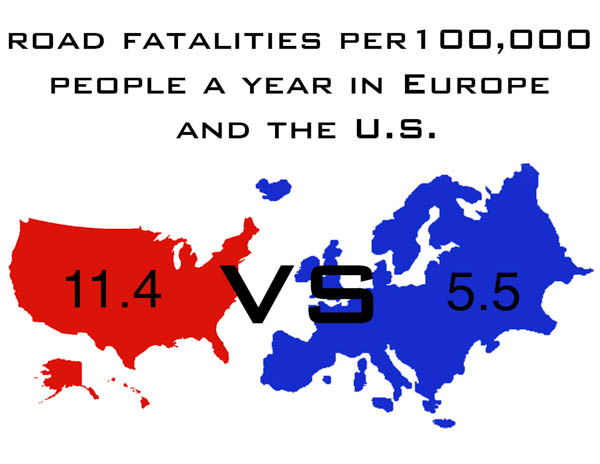Photo by: Abby Bellow
A recent study by The Economist revealed that fewer Europeans die on the roads than Americans.
“There were only three of every 100,000 Swedes dying on the roads each year, compared with 5.5 per 100,000 across the European Union, [and] 11.4 in America,” “Why Sweden Has So Few Road Deaths”, written by The Economist said. “Sweden’s roads have become the world’s safest.”
In spite of these statistics, road accidents in America have shown signs of declining.
“Although compared to Europe the United States has high accident-related incidents, since the 1940s, accidents on the road in America have been decreasing due to better education, people wearing safety belts and newer vehicles with better safety standards,” The Economist said.
According to senior John Wood, European roads could be safer because they are well planned and built for safety over convenience.
“The European road system is also more modern than us,” Wood said. “Every municipality in the U.S. is responsible for their own roads and there is no one system that says this has to be to this standard, so everywhere you go the roads are going to be different. If you look at the width of lanes, it is going to vary from state to state.”
Compared to the United States – where the majority of the citizens have to drive, European citizens have a wider variety of options for transportation.
“The European transit system cannot compare to the United States,” Missionary-in-Residence Clyde Antwine said. “You can get anywhere on a city bus, but in Edmond you are cut off if you don’t have a car.”
Junior Carley Cave, who has been to Europe on Oklahoma Christian’s European Studies program in Vienna, Austria, noted that European roads are more pedestrian-friendly.
“The roads there are definitely smaller, and the cars are smaller,” Cave said. “They have very clean streets and lots of pedestrians walking everywhere. England has a good public transportation system. Here in America there is barely anything. They just now started getting the City Link buses.”
According to Wood, another reason why there are less road-related accidents in Europe is because most Europeans ensure pedestrians and cyclists have a safe zone.
“The Europeans have solved this problem by giving the cyclists their own space,” Wood said. “Europe is also more physically active than the U.S., so people are more likely to go bike or walk elsewhere rather than here. For an example, my roommate will literally drive 200 feet just because he does not want to walk to McDonald’s or Braum’s.”
However, Wood is hesitant about America adopting the European transportation system.
“I don’t think imitating the European road system would work for us because it is designed to travel from country to country where ours is not,” Wood said. “States would throw a fit if they have to communicate with their neighbors. I don’t think we can get each of our municipalities to communicate well. Also, keep in mind that the European road system is not designed to deal with the volumes of cars we have to deal with.”
Another factor to take into account is the driving age difference between Europe and America. In most European countries such as the United Kingdom, the driving age is 18, which could be another factor as to why there are fewer accidents in Europe.
“In European society kids are allowed to be kids a lot longer than here, so you don’t get your driver’s license at 16,” Antwine said. “The European highways are really superhighways and they are well kept and they drive fast because they know how, and you don’t have young drivers on the road. I am not prejudiced against young people, but if you asked me why the roads are safer in Europe, I would say that is the main reason.”
Sweden’s goal is to reduce the number of road deaths to zero by 2018. According to The Economist, Sweden, which is well on its way to accomplishing its goal, plans to test the first driverless car in 2018.
“I think we are going to need some driverless cars for day-to-day work, like driving to the office,” Wood said. “It would be a great idea if we started adopting the fast train system like Japan uses for longer distance travel and you could make the roads safer for people to travel from point A to point B. The only way we are going to arrive to an accepted conclusion is if we as a society say we have a problem and here is how we are going to solve it – but that would take forever.”












Be First to Comment